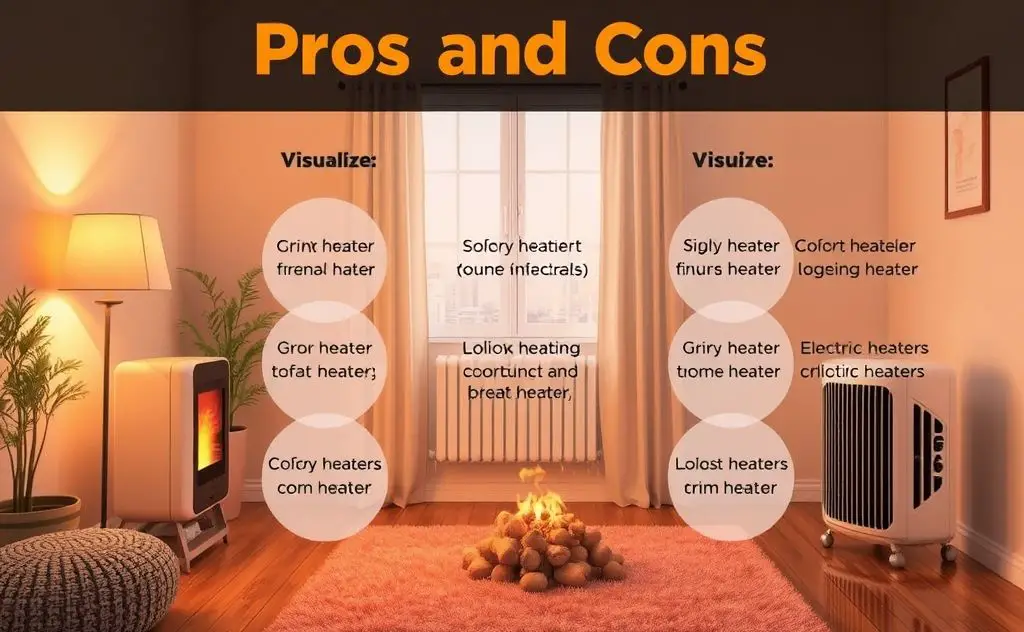Electric heaters come in various types, each with distinct pros and cons: convection heaters offer even warmth but can be slow to heat a space; radiant heaters provide instant heat but may not warm large areas; oil-filled radiators retain heat well and are energy-efficient but can be bulky; and fan-forced heaters heat quickly but may be noisy and less energy-efficient, making it essential to choose based on your specific heating needs and preferences.
Electric heaters offer versatile heating solutions for homes, offices, and outdoor spaces. Understanding the differences between types helps you choose the right one for your needs.

Oil-Filled Radiator Heaters
Oil-filled heaters use diathermic oil to store and radiate heat. They’re known for their steady warmth and silent operation.
Pros
- Retain heat long after turning off
- Operate silently without fans
- Energy efficient for continuous use
- Even heat distribution across rooms
Cons
- Slow to reach full heating capacity
- Heavy and difficult to move
- Surface gets extremely hot to touch
- Higher wattage models increase electricity costs
For more details on oil-filled models, see our oil-filled radiator guide.

Ceramic Space Heaters
Ceramic heaters use heating elements with ceramic plates for rapid warmth. They’re popular for their portability and quick heat-up time.
Pros
- Heat rooms within minutes
- Lightweight and portable designs
- Available with oscillation features
- Cool-touch exteriors on many models
Cons
- Fan noise can be distracting
- Less effective in large spaces
- Ceramic plates degrade over time
- Can dry out air in the room
Learn about ceramic heating technology for more technical details.
Infrared Heaters
Infrared heaters emit electromagnetic radiation that directly warms objects and people rather than the air.
Pros
- Instant heat when turned on
- Silent operation without fans
- Don’t reduce humidity levels
- Energy efficient for spot heating
Cons
- Heat doesn’t circulate well
- Requires direct line of sight
- Safety concerns with high-intensity models
- Limited range of effectiveness
For more on how these work, read our article on infrared heating technology.
Quartz Heaters
Quartz heaters are a type of infrared heater that use quartz tubes to generate and emit heat.
Pros
- More durable than ceramic elements
- Faster heat-up than oil-filled models
- Energy efficient for targeted heating
- Long lifespan with proper care
Cons
- Bright glow can be distracting
- Not ideal for whole-room heating
- Quartz tubes can be fragile
- Limited models with thermostats
Fan Heaters
These basic electric heaters use a heating coil and fan to circulate warm air quickly.
Pros
- Most affordable electric heater type
- Extremely fast heat delivery
- Compact and lightweight designs
- Available in many sizes
Cons
- Noisiest electric heater option
- Can create dry air conditions
- Open coils pose fire risks
- Higher energy consumption
Comparing Energy Efficiency
| Heater Type | Average Wattage | Best Use Case | Estimated Cost/Hour* |
|---|---|---|---|
| Oil-Filled | 1500W | Continuous room heating | $0.18 |
| Ceramic | 1500W | Quick personal heating | $0.18 |
| Infrared | 1000W | Spot heating | $0.12 |
| Fan Heater | 2000W | Fast air heating | $0.24 |
*Based on average U.S. electricity rate of $0.12 per kWh
Safety Considerations
All electric heaters carry some safety risks that users should understand:
- Keep at least 3 feet from flammable materials
- Never leave operating heaters unattended
- Plug directly into wall outlets (no extension cords)
- Look for tip-over and overheat protection
- Place on stable, level surfaces
The Consumer Product Safety Commission reports space heaters cause about 1,700 fires annually. Modern safety features have reduced risks significantly.
Choosing the Right Heater
Consider these factors when selecting an electric heater:
Room Size
Measure your space and match heater capacity. Most manufacturers provide square footage recommendations.
Usage Patterns
For occasional use, ceramic or infrared work well. Oil-filled models better suit continuous heating needs.
Noise Sensitivity
If quiet operation matters, avoid fan heaters and look for oil-filled or infrared models.
Portability Needs
Frequent movers should consider lightweight ceramic heaters over heavier oil-filled units.
For alternative heating options, explore our guide to non-electric heaters.
